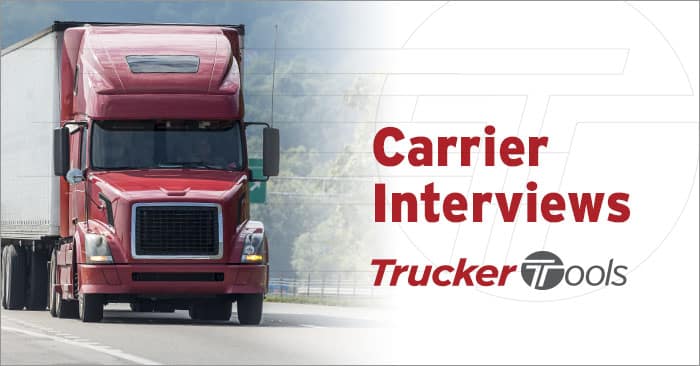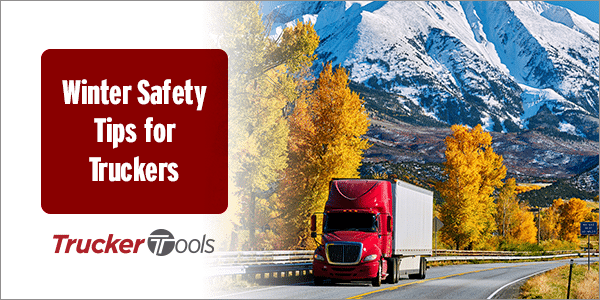Trucker Tools recently interviewed owner operator Wayne Cragg to learn more about his life on the road as a flatbedder and about his career in trucking. Wayne is a veteran of the U.S. Navy who mostly hauls glass and steel. He often has to deal with snow and ice on his runs across the country. During our conversation, Wayne shared some things he’s learned through the years about winter driving and how to deal with cold climates when you’re on the road, which we share here.
1. Stay Up To Date on the Weather, Chain Laws
According to Wayne, trip-planning is essential when you’re running through ice and snow. Monitoring weather forecasts on a daily basis for the regions you’ll be traveling throughwill allow you to avoid snowstorms, black ice, whiteout conditions and Nor’easters — all of which can slow you down and get you into accidents. Wayne told us that he uses a variety of sources for staying updated on weather conditions.
“I keep up with the weather with three different apps: Weather Nation, AccuWeather and The Weather Channel,” Wayne shared. “Some states have digital billboards set up with winter storm warnings. I also sometimes go to the Colorado highway’s website to get information on their chain laws. I sign up for email updates from some highway associations to stay on top of their chain laws, as well.”
“I keep up with the weather with three different apps: Weather Nation, AccuWeather and The Weather Channel,” Wayne shared. “Some states have digital billboards set up with winter storm warnings. I also sometimes go to the Colorado highway’s website to get information on their chain laws. I sign up for email updates from some highway associations to stay on top of their chain laws, as well.”
2. Be Prepared for Bad Weather
It’s always a good idea to bring extra supplies with you when you know you’re going to be trucking through ice and snow. Wayne recommends packing a sleeping bag that stays warm below zero, extra food and water, and a winter hat and gloves with you.
“You have to be prepared,” Wayne said. “I have a sleeping bag that is rated for minus 10 degrees. There’s a couple of reasons for that — in case the truck breaks down during a snowstorm and also because you can use the sleeping bag to keep your water and food from freezing. I broke down in Canada one time and had plenty of water, but if your truck breaks down and it’s below freezing, your water freezes. I just tuck my water and food into the sleeping bag and they won’t freeze.”
Don’t Let Your Chain Locks Freeze
“I made a huge mistake early on when I didn’t cover the lock on my chains and it was exposed to all the elements,” said Wayne. “When I tried to unlock it, I couldn’t because the lock was frozen with salt and ice. It was like a rock. I couldn’t get the key in. I was basically stuck. I couldn’t put the chains on and then I had to have someone come out with a bolt cutter and cut them off.”
“I made a huge mistake early on when I didn’t cover the lock on my chains and it was exposed to all the elements,” said Wayne. “When I tried to unlock it, I couldn’t because the lock was frozen with salt and ice. It was like a rock. I couldn’t get the key in. I was basically stuck. I couldn’t put the chains on and then I had to have someone come out with a bolt cutter and cut them off.”
Wayne now covers his chain locks with cut tennis balls to make sure they stay free of road salt, ice and dirt. He told us that some truckers put a sandwich bag over the tennis ball for double protection from the elements, as well. Wayne also noted that you should make sure your chains are in good working order before putting them on your tires.
Top off Windshield Wiper Fluid Daily
It’s a good idea to get into the habit of topping off your windshield wiper solvent at the beginning of every day, especially in winter weather. Wayne suggests making it part of your everyday pre-trip.
“I always make sure it’s 100 percent full in the morning,” Wayne said. “In New Mexico just last week, they had four to eight inches of snow and I used about three quarters of my windshield wiper solvent. I also always add de-icer.”
“I always make sure it’s 100 percent full in the morning,” Wayne said. “In New Mexico just last week, they had four to eight inches of snow and I used about three quarters of my windshield wiper solvent. I also always add de-icer.”
Tip Sun Visors To Heat Up Your Windshield
Temperatures and humidity levels are constantly changing, which is why your windshield fogs up when it’s cold and when it rains. When the air inside is warmer than the outside air, it causes condensation on the inside of your windshield, which makes it appear foggy. If your defroster doesn’t work as well as it should, Wayne suggests using your sun visors to reflect heat onto the windshield.
“If you turn your sun visors toward the windshield itself, it keeps that heat on the windshield,” Wayne said. “It helps a lot, believe it or not. Most of the trucks now have three visors. If you push them close to the windshield and tip them up, it catches that heat and you can keep it right on the windshield.”
For the rest of our conversation with Wayne, read Flatbedding and Trucking Truths with Wayne Cragg. To download Trucker Tools’ free, all-in-one driver app, visit https://www.truckertools.com/carriers/.







